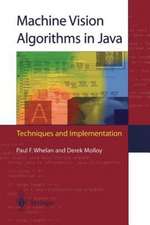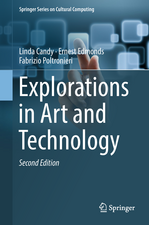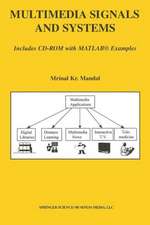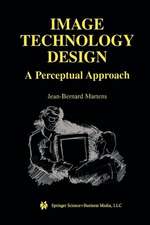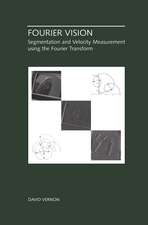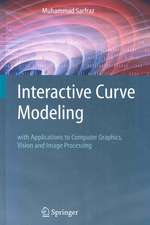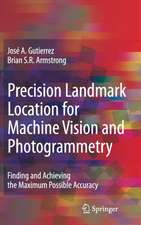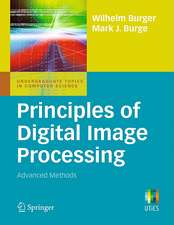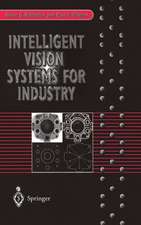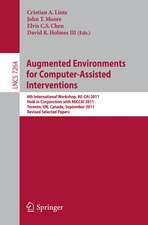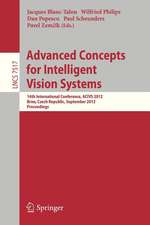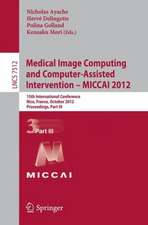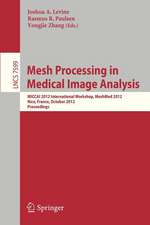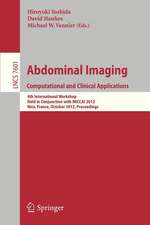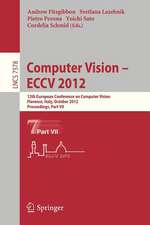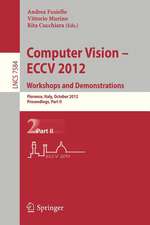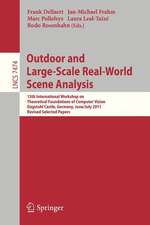Digital Image Processing: An Algorithmic Introduction
Autor Wilhelm Burger, Mark J. Burgeen Limba Engleză Paperback – 24 iul 2023
This modern, self-contained textbook provides an accessible introduction to the field from the perspective of a practicing programmer, supporting a detailed presentation of the fundamental concepts and techniques with practical exercises and fully worked out implementation examples. This much-anticipated 3rd edition of the definitive textbook on Digital Image Processing has been completely revised and expanded with new content, improved illustrations and teaching material.
Topics and features:
- Contains new chapters on fitting of geometric primitives, randomized feature detection (RANSAC), and maximally stable extremal regions (MSER).
- Includes exercises for most chapters and provides additional supplementary
- materials and software implementations at an associated website.
- Uses ImageJ for all examples, a widely used open source imaging environment that
- can run on allmajor platforms.
- Describes each solution in a stepwise manner in mathematical form, as abstract pseudocode algorithms, and as complete Java programs that can be easily ported to other programming languages.
- Presents suggested outlines for a one- or two-semester course in the preface.
Advanced undergraduate and graduate students will find this comprehensive and example-rich textbook will serve as the ideal introduction to digital image processing. It will also prove invaluable to researchers and professionals seeking a practically focused self-study primer.
| Toate formatele și edițiile | Preț | Express |
|---|---|---|
| Paperback (1) | 582.34 lei 6-8 săpt. | |
| Springer International Publishing – 24 iul 2023 | 582.34 lei 6-8 săpt. | |
| Hardback (1) | 455.01 lei 6-8 săpt. | |
| SPRINGER LONDON – 7 apr 2016 | 455.01 lei 6-8 săpt. |
Preț: 582.34 lei
Preț vechi: 727.92 lei
-20% Nou
Puncte Express: 874
Preț estimativ în valută:
111.44€ • 115.69$ • 92.93£
111.44€ • 115.69$ • 92.93£
Carte tipărită la comandă
Livrare economică 22 martie-05 aprilie
Preluare comenzi: 021 569.72.76
Specificații
ISBN-13: 9783031063435
ISBN-10: 3031063430
Pagini: 945
Ilustrații: XXV, 945 p. 446 illus., 369 illus. in color.
Dimensiuni: 178 x 254 x 52 mm
Greutate: 1.81 kg
Ediția:3rd ed. 2022
Editura: Springer International Publishing
Colecția Springer
Locul publicării:Cham, Switzerland
ISBN-10: 3031063430
Pagini: 945
Ilustrații: XXV, 945 p. 446 illus., 369 illus. in color.
Dimensiuni: 178 x 254 x 52 mm
Greutate: 1.81 kg
Ediția:3rd ed. 2022
Editura: Springer International Publishing
Colecția Springer
Locul publicării:Cham, Switzerland
Cuprins
1. Digital Images.- 2. ImageJ.- 3. Histograms and Image Statistics.- 4. Point Operations.- 5. Filters.- 6. Edges and Contours.- 7. Corner Detection.- 8. Finding Simple Curves.- 9. Morphological Filters.- 10. Regions in Binary Images.- 11. Automatic Thresholding.- 12. Color Images.- 13. Color Quantization.- 14. Colorimetric Color Spaces.- 15. Filters for Color Images.- 16. Edge Detection in Color Images.- 17. Edge-Preserving Smoothing Filters.- 18. Introduction to Spectral Techniques.- 19. The Discrete Fourier Transform in 2D.- 20. Geometric Operations.
Notă biografică
Dr. Wilhelm Burger is a faculty member of the University of Applied Sciences Upper Austria, Hagenberg, where he serves as Director of the Digital Media degree programs at the School of Informatics, Communications and Media.
Dr. Mark J. Burge is a scientist at the non-profit organization Noblis in Falls Church, VA, USA. His other publications include the Handbook of Iris Recognition.
Dr. Mark J. Burge is a scientist at the non-profit organization Noblis in Falls Church, VA, USA. His other publications include the Handbook of Iris Recognition.
Textul de pe ultima copertă
This modern, self-contained textbook provides an accessible introduction to the field from the perspective of a practicing programmer, supporting a detailed presentation of the fundamental concepts and techniques with practical exercises and fully worked out implementation examples. This much-anticipated 3rd edition of the definitive textbook on digital image processing has been completely revised and expanded with new content, improved illustrations and teaching material.
Topics and features:
- Contains new chapters on fitting of geometric primitives, randomized feature detection (RANSAC), and maximally stable extremal regions (MSER)
- Includes exercises for most chapters and provides additional supplementary materials and software implementations at an associated website
- Uses ImageJ for all examples, a widely used open source imaging environment that can run on all major platforms
- Describes each solution in a stepwise manner in mathematical form, as abstract pseudocode algorithms, and as complete Java programs that can be easily ported to other programming languages
- Presents suggested outlines for a one- or two-semester course in the preface
Advanced undergraduate and graduate students will find this comprehensive and example-rich textbook will serve as the ideal introduction to digital image processing. It will also prove invaluable to researchers and professionals seeking a practically focused self-study primer.
Dr. Wilhelm Burger is an emeritus of the University of Applied Sciences Upper Austria at
Hagenberg, where he served as Head of the Digital Media degree programs at the School of
Informatics, Communications and Media.
Dr. Mark J. Burge is the Senior Advisor for Artificial Intelligence at the Federal Bureau of
Investigation, Washington, DC, USA. His other publications include the Handbook of Iris
Recognition.
Caracteristici
Presents an accessible introduction to the methods of digital image processing Describes the most important procedures, with formal and mathematical aspects discussed at a fundamental level Provides examples and exercises in the text, as well as supplementary material at an associated website
Recenzii
“This textbook is an excellent introduction to the fundamentals of digital image processing. It thoroughly blends basic theory and practical algorithms expressed in Java and Image. It also provides a set of accessible exercises at the end of each chapter. It is suitable as a two-semester textbook for third-year undergraduates.” (B. Belkhouche, Computing Reviews, November, 2016)


